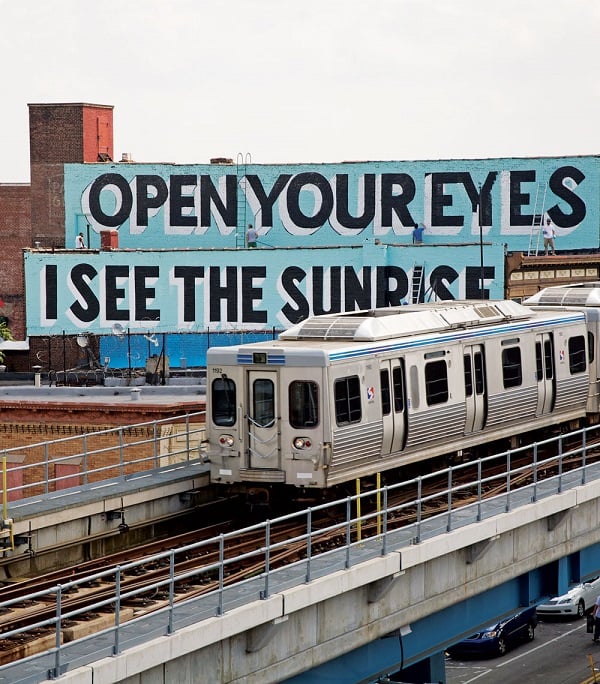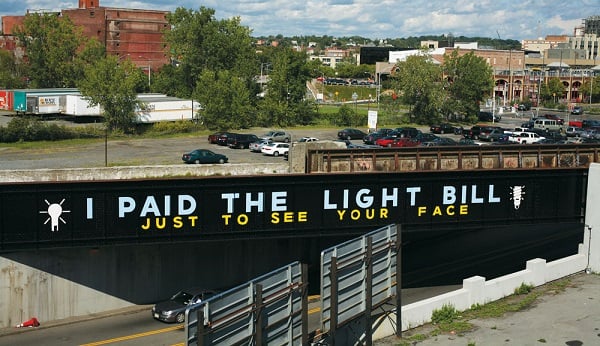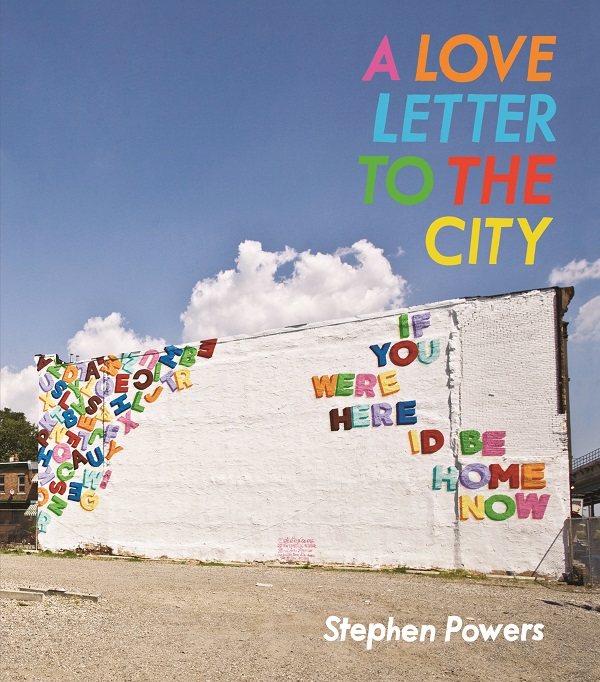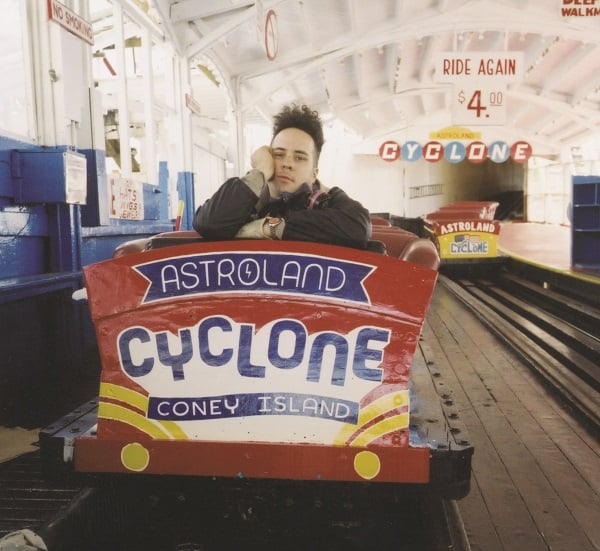Art World
Stephen Powers’s New Book Is a Public Art Manifesto
The globetrotting muralist Stephen Powers lets us in on the stories behind his best-known projects.

The globetrotting muralist Stephen Powers lets us in on the stories behind his best-known projects.

Benjamin Sutton


Stephen Powers mural in Syracuse, New York.
Photo: Adam Wallacavage.
Stephen Powers‘s public art installations feature phrases and poetic fragments that he sources from public meetings, curbside encounters, and exchanges with neighborhood historians. That process is the focus of a new book in which he chronicles the creation of dozens of murals around the world.
“The power of walls manifests itself when you’re walking past them and you see people looking at them and talking about them, and it’s about the subtle ways it impacts people’s lives,” explains Powers, an artist whose murals are spread across the globe, from Belfast and Brooklyn to Johannesburg and São Paulo, always taking cues from the visual culture and spoken word of each locale. “The process for me is more akin to setting up the podium and the speakers and getting the microphone to the right height for somebody, and trying to coax people into using the microphone.”
Powers’s public art practice, which is rooted in the iconography, lingo, and techniques of vintage, hand-painted signs, is always speaking the language of advertising while simultaneously subverting it. His site-specific murals and billboard-sized pronouncements evoke slogans and logos, but cause the eye to linger due to their status as handmade things in a field dominated by mechanically produced red signs and images. “Anywhere is paradise with you,” reads a mural resembling a vintage amusement park marquee in Dublin. “Prepay is on; let’s talk until my minutes are gone,” proposes a mural in Philadelphia that resembles a billboard hawking cell phones. In his public art projects, Powers reclaims the city’s walls from the grips of advertisers to give citizens a voice.
“His murals humanize the anonymity of the urban landscape, not least because he works closely with the communities who see them,” writes MoMA PS1 curator Peter Eleey in the foreword of A Love Letter to the City, Powers’s new book from the Princeton Architectural Press. Powers will be having a book launch at New York’s Strand Book Store on March 25 at 7 p.m. He has already begun making a number of discreet murals within the bookstore, and will be painting one on its exterior beginning Tuesday, March 18.

“A Love Letter to the City” book cover.
Photo: Adam Wallacavage. Courtesy the artist, Princeton Architectural Press.
“The Strand is like a church, it’s warm and it’s filled every day with devotees going up and down its aisles; our task is to add things in the quiet corners of the place that enhance the experience of being there,” Powers says. “I think the written word has never been in a more precarious place. And I also like endangered places, and I think a place loaded with words is an endangered place, a rare beauty. We’re going to go to the ends of aisles in the basement, we’re going to go to peek around the corners of the store and we’re gonna paint little tributes to writing and the act of reading, because they’re both very symbiotic creative acts.”
The book Powers has written provides an overview of his public projects in seven major cities, as well as ICY Signs, the hand-painted sign business Powers launched in Coney Island, Brooklyn, in 2003. In addition to extensive photo documentation of each project, the chapters include images of source materials—among them are preliminary sketches, snapshots of colorful Brazilian foodstuffs packaging, and responses to a poll Powers sent to residents in Syracuse, New York—profiles of collaborators, and Powers’s accounts of how the projects unfolded. His recollections cover everything from community conferences in Philadelphia—where one attendee suggested “Do Michael Jackson moonwalking up there” on the day the singer died—to portentous artifacts discovered during the final stages of painting a 10-story mural in Johannesburg. For an artist whose art practice is devoted to text, penning the diary-like narratives about each project was a challenging endeavor.

Stephen Powers mural in Philadelphia, Pennsylvania.
Photo: Adam Wallacavage.
“I kept pushing off the writing, and the first several drafts were just transcriptions from talks I’d given, and there was no cohesive thought as to what the text was gonna be until maybe about six months ago, when I really hunkered down and wrote everything,” Powers says. “I had very patient editors. There’s a lot of writing, and a lot going on in terms of explaining what the work is, and hopefully offering a how-to primer on future public art projects.”

Stephen Powers in Coney Island, Brooklyn.
Photo: Lula Rae.